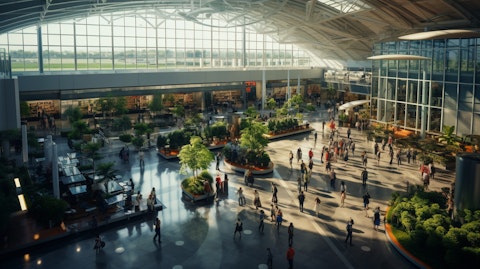In this article, we will take a look at the 15 worst airports in the U.S. for connecting flights. If you would like to skip our analysis of the airline industry, you can go directly to the 5 Worst Airports in the U.S. for Connecting Flights.
The aviation industry faced serious disruptions during the COVID-19 pandemic. However, global air travel demand has almost returned to pre-pandemic levels, with the total air traffic volume for 2023 reaching 94.1% of 2019 levels. Domestic travel in 2023 was higher than 2019 levels by 3.9%. Meanwhile, international air traffic recorded a growth of 41.6% compared to the previous year. Impressively, it reached 88.6% of the levels observed in 2019. The majority of travel during the year was directed towards Europe, holding the highest share at 31%, followed by North America at 29%, and Asia Pacific at 22%. As air travel rebounds, passengers are increasingly seeking better airport processes for a more convenient journey.
According to industry predictions for 2024, airports, just like cities, have many infrastructure and technological requirements. The focus of airlines this year is on implementing intelligent fuel alternatives such as electric buses, electric-powered ground handling equipment, and sustainable aviation fuel (SAF). The adoption of technologies like biometric scanners and passenger management systems is helping airports improve the overall travel experience, making it more efficient for both passengers and airport operations.
Numerous industry experts think that artificial intelligence (AI) can play an important role in providing operational support and efficiency, particularly in routine tasks such as baggage processing, staffing, duty scheduling, energy usage, and crisis management during rush hours. Common travel issues, including passenger facilities during travel and between connections, continue to be a focus. To avoid such issues, travelers often seek information about the best airports for connecting flights or try to avoid the worst airports for layovers.
The airline industry is projected to achieve net profits of $25.7 billion, reflecting a 2.7% net profit margin in 2024. This marks an improvement from the estimated $23.3 billion net profit and 2.6% net profit margin in 2023. Furthermore, the number of air passengers is predicted to reach 4.7 billion in 2024. This increase in passenger numbers is prompting consumer demands for improvements across many airports. Many airport stocks such as Fraport AG (OTC:FPRUY), Grupo Aeroportuario del Centro Norte (NASDAQ:OMAB), Airports of Thailand Public Company Limited (OTC:AIPUY) are investing in tech-related services to improve their operational efficiency. The airline and airport industries may undergo a shift in strategy as concerns about climate change and sustainability increase for the high-carbon print industry. You can check out the 12 Best Airport Stocks To Buy here.
Grupo Aeroportuario del Centro Norte’s (NASDAQ:OMAB) CEO Ricardo Duenas shared an update on the company’s financial situation in the Q3 2023 earnings call. Here’s what Duenas said:
“OMA continued to deliver solid financial and operating results during the third quarter. Adjusted EBITDA grew 33% in the quarter to MXN2.5 billion and adjusted EBITDA margin reached 79.4% largely as a result of the increase in both aeronautical and non-aeronautical revenues on our successful cost control strategy. In the third quarter, OMA’s passenger traffic reached a record number of 7.4 million, an increase of 19% versus the third quarter of last year. Outstanding results were guided by the performance in Monterrey, which accounted for 62% of OMA’s total passenger growth as compared to the third quarter of last year. The main destinations at road traffic growth were Toluca, Queretaro, Cancun, Santa Lucia, and Mexico City.”

An aerial view of a bustling international airport terminal.
Our Methodology
To shortlist the 15 worst airports in the U.S. for connecting flights, we analyzed a number of reports from reputable sources like Finance Buzz, Frommer’s, and Johnny Jet. We also consulted data studies from Finance Buzz and Upgraded Points that analyzed 50 of the busiest airports in the US on the basis of various factors such as on-time flight percentages, airport facilities, nearby hotels, shopping options, and average delay durations. The worst airports in the U.S. for connecting flights have been ranked in ascending order of their scores, with a higher score indicating a more significant degree of poor service.
By the way, Insider Monkey is an investing website that tracks the movements of corporate insiders and hedge funds. By using a consensus approach, we identify the best stock picks of more than 900 hedge funds investing in US stocks. The top 10 consensus stock picks of hedge funds outperformed the S&P 500 Index by more than 140 percentage points over the last 10 years (see the details here). Whether you are a beginner investor or professional one looking for the best stocks to buy, you can benefit from the wisdom of hedge funds and corporate insiders.
15 Worst Airports in the U.S. for Connecting Flights
15. Nashville International Airport
Code: BNA
Score: 44.2
Nashville International Airport (BNA) is about 8 miles away from the city of Nashville, Tennessee, and is a medium-sized airport. The airport serves 13 airlines and hosts flights to over 100 destinations. With 54 gates, the airport has an average of 0.54 shops or restaurants and four lounges per gate. The percentage of flights that get delayed by over an hour at the airport is over 6%.
14. Minneapolis–Saint Paul International Airport (MSP)
Code: MSP
Score: 44.7
US News cites the Minneapolis–Saint Paul International Airport as the 15th busiest airport in the US and the 27th busiest in the world. The airport has two terminals that are linked through a skyway and a total of 131 gates. The average connection delay at the airport is over an hour, and walking from one terminal to another takes at least 28 minutes. Meanwhile, the average number of shops or restaurants per gate is 0.88.
13. Washington Dulles International Airport
Code: IAD
Score: 46.73
Washington Dulles International Airport has three terminals and 113 gates. The airport is a central hub for American Airlines and United Airlines. The terminals are connected through a shuttle service, and passengers need to take the AeroTrain to avoid the long distances between concourses and terminals. The time required to walk from one terminal to another is 30 minutes, and the average delay in connections is over 76 minutes.
12. Sacramento International Airport
Code: SMF
Score: 47.2
The Sacramento International Airport has two terminals for domestic and international flights and 32 gates. Around 22% of flights are delayed; the average delay time is 58 minutes. The shopping and dining options are spread out at the airport, but there are no onsite hotels for passengers who have long layovers. The average security or waiting time for the airport stands at 17 minutes.
11. Fort Lauderdale–Hollywood International Airport
Code: FLL
Score: 47.83
Located just 5 miles from Fort Lauderdale, Fort Lauderdale–Hollywood International Airport comprises four terminals and houses a total of 66 gates. The airport is busy with multiple commercial flights, but 34% of these flights experience delays. On average, departures are delayed by around 74 minutes. Although the airport does not provide onsite hotels, it compensates with a variety of shops and restaurants. Meanwhile, the average distance between gates is 25 minutes.
10. Salt Lake City International Airport
Code: SLC
Score: 48.31
The Salt Lake City International Airport has two terminals and 83 gates. The airport serves over 25 million passengers per year. It is a hub for Delta Air Lines and a priority city for American Airlines. The airport has an average delay rate of 19% and an average delay time of 69 minutes. In addition, the airport has far-spread lounges and no onsite hotels for passengers facing extended layovers.
9. Los Angeles International Airport
Code: LAX
Score: 48.63
Los Angeles International Airport is the second busiest airport in the US and offers plenty of shopping and dining options through its eight terminals and 146 gates. It takes 53 minutes to move across terminals at the airport, and about 23% of departing flights are delayed. The average delay in arrivals and departures is similar at around 68 minutes. There are no on-site hotels at the airport.
8. George Bush Intercontinental Airport
Code: IAH
Score: 48.85
The George Bush Intercontinental Airport is commonly reviewed as amongst the worst airports in the US for its long wait times and overall inconvenience. The airport has five terminals and 161 gates. Approximately 24% of all flights departing from the airport experience delays, with an average delay duration of 73.41 minutes. Meanwhile, it takes 26 minutes to travel across terminals. Reviewers on various platforms have complained about poor traffic management around the airport and lack of proper planning to accommodate travelers. The George Bush Intercontinental Airport is at the eighth position on our list of the worst airports in the U.S. for connecting flights.
7. Hartsfield-Jackson International Airport
Code: ATL
Score: 49.69
The Hartsfield-Jackson International Airport has two terminals and 192 gates. It is the busiest airport in the US, with over 100 million passengers traveling through it yearly. Approximately 23% of these passengers experience delays, with an average delay time of 62 minutes. Navigating between gates involves an average walk time of 27 minutes. The airport is reviewed as poorly maintained and understaffed. Many reviewers also complain about the poor traffic planning outside the airport.
6. Tampa International Airport
Code: TPA
Score: 50.16
Situated just 5 miles from downtown Tampa, the Tampa International Airport has four terminals and a total of 60 gates. Departures from the airport experience a 25% delay rate, with an average delay time of 72 minutes, while arrivals face a 28% delay rate, with an average delay of 68 minutes. The airport lacks charging stations per mile but compensates with an average of 15 shopping and dining options per mile. However, travelers may encounter challenges with low WiFi download speeds and a security wait time of at least 20 minutes.
Many airport companies such as Fraport AG (OTC:FPRUY), Grupo Aeroportuario del Centro Norte (NASDAQ:OMAB), Airports of Thailand Public Company Limited (OTC:AIPUY) are making investments in technology-related services to increase their operational efficiency.
Click to continue reading and see the 5 Worst Airports in the U.S. for Connecting Flights.
Suggested Articles:
- 12 Best Autonomous Driving Stocks To Buy Now
- 20 Cities with the Highest Quality of Life in the US
- 13 Best Energy Stocks To Invest In According to Hedge Funds
Disclosure: None. 15 Worst Airports in the U.S. for Connecting Flights is published on Insider Monkey.





